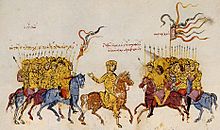Thomas the Slav | |
|---|---|
 Miniature from the Madrid Skylitzes version of the chronicle of John Skylitzes depicting Thomas, on horseback and dressed as a Byzantine emperor, negotiating with the Arabs. The rebellion of Thomas is one of the most richly illustrated episodes in the chronicle.[1] | |
| Born | c. 760 Gaziura (modern-day Turhal, Tokat, Turkey) |
| Died | 823 Arcadiopolis (modern-day Lüleburgaz, Kırklareli, Turkey) |
| Allegiance | Byzantine army |
| Years of service | c. 803 – 820 |
| Rank | tourmarches |
Thomas the Slav (Greek: Θωμᾶς, romanized: Thōmas, c. 760 – October 823) was a 9th-century Byzantine military commander, most notable for leading a wide-scale revolt in 821–23 against Emperor Michael II the Amorian (r. 820–829).
An army officer of Slavic origin from the Pontus region (now north-eastern Turkey), Thomas rose to prominence, along with the future emperors Michael II and Leo V the Armenian (r. 813–820), under the protection of general Bardanes Tourkos. After Bardanes' failed rebellion in 803, Thomas fell into obscurity until Leo V's rise to the throne, when Thomas was raised to a senior military command in central Asia Minor. After the murder of Leo and usurpation of the throne by Michael the Amorian, Thomas revolted, claiming the throne for himself. Thomas quickly secured support from most of the themes (provinces) and troops in Asia Minor, defeated Michael's initial counter-attack and concluded an alliance with the Abbasid Caliphate. After winning over the maritime themes and their ships as well, he crossed with his army to Europe and laid siege to Constantinople. The imperial capital withstood Thomas's attacks by land and sea, while Michael II called for help from the Bulgarian Khan Omurtag. Omurtag attacked Thomas's army, but although repelled, the Bulgarians inflicted heavy casualties on Thomas's men, who broke and fled when Michael took to the field a few months later. Thomas and his supporters sought refuge in Arcadiopolis, where he was soon blockaded by Michael's troops. In the end, Thomas's supporters surrendered him in exchange for a pardon, and he was executed.
Thomas's rebellion was one of the largest in the Byzantine Empire's history, but its precise circumstances are unclear due to competing historical narratives, which have come to include claims fabricated by Michael to blacken his opponent's name. Consequently, various motives and driving forces have been attributed to Thomas and his followers. As summarized by the Oxford Dictionary of Byzantium, "Thomas's revolt has been variously attributed to a reaction against Iconoclasm, a social revolution and popular uprising, a revolt by the Empire's non-Greek ethnic groups, Thomas's personal ambitions, and his desire to avenge Leo V."[1] Its effects on the military position of the Empire, particularly vis-à-vis the Arabs, are also disputed.